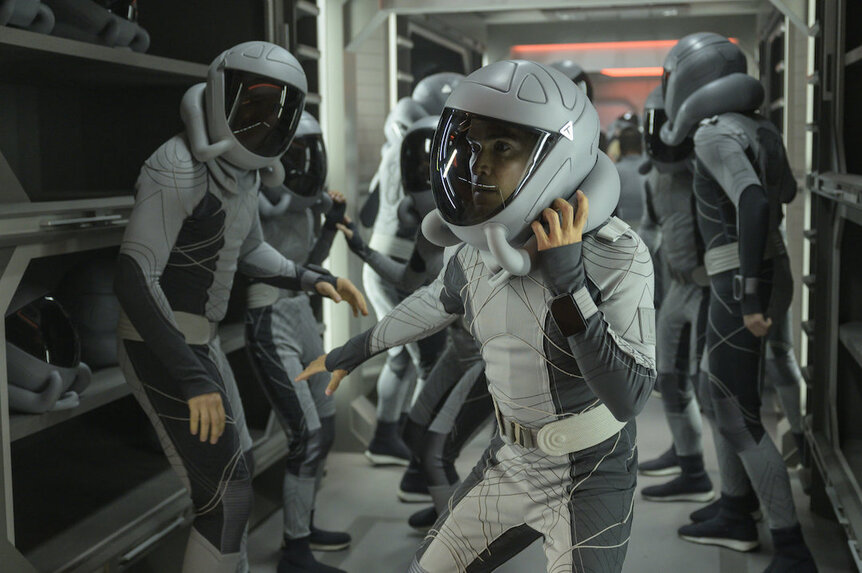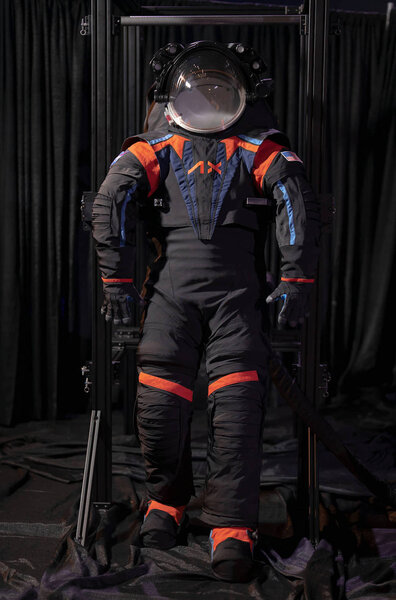Create a free profile to get unlimited access to exclusive videos, sweepstakes, and more!
How do NASA's new Artemis space suits stack up against our favorite sci-fi gear?
We don't want to die, but we don't want to look like dorks either.

So many of our favorite space-based stories take place a long way from home. Even The Martian, which is among the most realistic science fiction stories in recent memory, takes place all the way on Mars, more than 500 times the distance from the Earth to the Moon. But you don’t need to travel 20 trillion miles, like the crew of the Ark One (from SYFY's new show The Ark), or even 121 million miles to Mars, like Mark Watney, in order for space to come at you sideways. That can happen as soon as you leave Earth’s front door.
In space (no one can hear you scream), astronauts need to bring their own air and atmospheric pressure, but that’s only the beginning. A good space suit also needs to maintain a stable temperature and protect its wearer from radiation. Those are things we don’t usually think about, thanks to a combination of the atmosphere and Earth’s magnetic field.
RELATED: How do you make a spaceship? We asked the designer of Ark One from SYFY’s new series ‘The Ark’
With that in mind, NASA partnered with Axiom Space to design the next class of space suits for use during Artemis III (shown below). These are the suits astronauts will use when humanity returns to the lunar surface for the first time in more than half a century. They might be the cutting edge of human-made extraterrestrial fashion, but we got to wondering how they compare to the suits from some of our favorite onscreen astronauts.
THE ARK
The crew of the Ark One don’t need suits capable of walking on the surface of a planet because there isn’t a planet within a light year. That’s sort of their problem. But they do need suits capable of keeping them safe in the event of pressure loss and operating outside of the ship during extravehicular activities (EVAs).
Dean Devlin, creator of The Ark (airing on SYFY every Wednesday at 10 p.m. ET. with new episodes streaming next day on Peacock!) had this to say about the suits in the show during an interview with IGN: “This is inspired by one that’s actually being designed by MIT. It grabs onto every artery of your body to control your blood flow, and then it tightens up. The helmet, we wanted to do something where the helmets have the oxygen tank as part of the helmet instead of the standard one on the back.”
Costume designers built on that foundation of real space suits and incorporated inspiration from other science fiction classics like Star Wars and The Black Hole, as well as modern space tech companies like SpaceX. The idea was to marry the feelings that the suits could actually exist, while still existing within a storied history of fictional space suits.
2001: A SPACE ODYSSEY
It’s unclear precisely what sorts of functions the suits in Stanley Kubrick’s sci-fi classic 2001: A Space Odyssey have, but we can make some educated guesses by comparing them with other suits. The squarish gadget on the chest as well as the connect tubing running around to the back look an awful lot like the actuator and umbilical of the oxygen purge system (OPS) on the Apollo suits.
The OPS is intended as emergency life support, providing up to 90 minutes of additional air in the event that the suit loses pressure or an astronaut runs out of their primary oxygen supply. It’s a good thing to have. The remainder of the gadgetry on the back of the suit probably relates to other critical systems like temperature regulation, ventilation, and communication.
RELATED: You can buy Dave’s iconic ‘2001: A Space Odyssey’ space suit, it’ll just cost around $300,000
Despite seeing the characters wear the suits in space, they don’t look like the sort of suit you would typically wear outside of a spacecraft. The overall design of the suit has more in common with the pumpkin suits worn inside the craft during shuttle launches. EVA suits are usually bulkier, because they are called upon to do more than maintain pressure and deliver breathable air.
More likely, they are an evolution of the IEVA suits used during parts of the Gemini program, which were designed for use both inside and outside of a spacecraft. Only the best for Dave.
THE MARTIAN
In designing the suits for The Martian, costume designer Janty Yates looked to NASA’s Z series suits: prototype EVA suits intended for future crewed missions. Ultimately, the constraints of actual space exploration proved too much and the team instead built the suits from scratch, according to Space.com.
At one point in the story, NASA’s director of media relations, Annie Montrose, asks for a photo of Watney alive. Mission Control reminds her that no one will be able to see his face, because of the helmet. That was a concern for Ridley Scott, as well, and the Z series helmets just didn’t provide the sort of visibility of actors' facial expressions they needed. They also needed the suits to look cool.
Maintaining a relationship with NASA throughout the design process resulted in a suit which does feel like it comes from the future, but it feels like it comes from our future. Impressively, the suits they ended up with actually performed like a space suit in a few key ways. Actors wore cooling systems beneath their suits, comprised of tubing which pumped cooled liquid around the body. The helmet also contained working ventilation, lighting, and communications systems, all of which would have made spending ten hours a day inside the suit a little more bearable.
BATTLESTAR GALACTICA
While they aren’t often worn onscreen, there are several types of space suits inside the universe of Battlestar Galactica (now streaming on Peacock!). We’re going to limit ourselves only to the human ones, and only to a couple of them.
Viper and Raptor crews wear flight suits while on missions inside their craft. They are slim and form-fitting, comprised of a one-piece suit with a zipper up the front and pressure seals at the wrists and neck. They are comparable to the high-altitude flight suits worn by test pilots on Earth and are the equivalent of a life jacket, intended only to keep you alive long enough to get somewhere safe.
The other common suit is the RDM, a more robust piece of equipment intended for EVAs outside of the ship and on the surface of alien worlds. The RDM is streamlined at the front, with little more than a few insignia and some front-facing lights mounted to the helmet. Behind, there is a backpack which contains life support and communications systems. These are not unlike our own EVA suits and would look perfectly at home wrapped around our own astronauts.
THE EXPANSE
The worlds of The Expanse have as many space suits as they do factions, and then some. The most common, and the most affordable, are environment suits. They are life preservers, at best, flimsy and prone to damage. They provide a pressure seal and a limited amount of air, but little in the way of protection from radiation or anything else. If all that stands between you and death is an environment suit, you’d better find a more permanent solution sooner than later.
The mid-tier suit and the best friend of corporate spacers and Belters alike, is the VAC suit. It’s a more robust skin which incorporates an external air supply and integrated food and water supplies which feed right into the helmet. Their coolest and one of their most important features are the built-in magnetic boots which assist maneuvering in microgravity.
The ultra wealthy or the well-connected can get a top of the line suit which forms to the body and includes body armor, real-time medical analysis, and environmental sensors, all controlled with chin controls or eye movements. These are suits so cool that even in our fantasies they are reserved only for the chosen few.
Axiom Extravehicular Mobility Unit (AxEMU)
The Artemis program is in full swing, following the success of Artemis I, and we are on track to have humans back on the lunar surface in the next few years. The first landing mission will be Artemis III, currently scheduled for launch some time in 2025, and when the crew get to the Moon, they are going to need a new suit.
NASA partnered with Axiom Space as a part of the same program that brought us the SpaceX partnership, to design the suits astronauts will wear when they return to the Moon. “NASA’s partnership with Axiom is critical to landing astronauts on the Moon and continuing American leadership in space. Building on NASA’s years of research and expertise, Axiom’s next generation spacesuits will not only enable the first woman to walk on the Moon, but they will also open opportunities for more people to explore and conduct science on the Moon than ever before," said NASA Administrator Bill Nelson, in a NASA statement.
RELATED: 'The Ark' co-creator Jonathan Glassner says he 'could write a whole show' on the subject of cloning
The suit, dubbed the Axiom Extravehicular Mobility Unit (AxEMU), is designed for use both on the lunar surface and in microgravity environments. It offers all of the protection and communication needed to safely operate in space and on the Moon while improving mobility and functionality.
Axiom presented the suit today during an event at Space Center Houston. The event was broadcast live on NASA’s livestream and a recording is available on NASA’s official YouTube channel. During the demonstration, the AxEMU’s chief engineer, James Stein, showed off the suit’s ease of movement by performing squats and moving around the stage easily. The helmet also has a wide viewing angle, allowing the astronaut to see and be seen from various angles, harkening back to Ridley Scott’s image of his Martian space suits.
Astronauts will enter the new suit from the back, like a butterfly emerging from a chrysalis in reverse. They’ll first step into the feet, then insert their arms and head. Finally, the suit will be closed up from behind. The actual production suit will differ somewhat from the prototype, particularly in color scheme.
The prototype stands in stark contrast to past suits with its black material and hints of blue and orange. The actual production suit will likely be white, like other EVA suits before it. If you’re upset at the loss of the cool factor the existing color scheme provides, blame physics. Darker materials retain too much heat and, without an atmosphere to help radiate that heat away, it puts to much strain on the suit to keep cool.
We don’t want our astronauts to cook inside their suits, even if it means they have to wear white on the Moon after labor day. Some concessions must be made for staying alive.
Speaking of staying alive in deep space, catch new episodes of The Ark every Wednesday at 10 p.m. ET. on SYFY, then streaming next day on Peacock!

































